|
|
|
Sort Order |
|
|
|
Items / Page
|
|
|
|
|
|
|
| Srl | Item |
| 1 |
ID:
147631
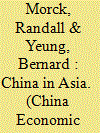

|
|
|
|
|
| Summary/Abstract |
China's surge to become the world's second largest economy and largest trading nation contributes greatly to Asia becoming the world's largest economic system. China is the nexus of intra-Asian trade and direct investment flows. China's rapid growth in the recent decade relied on a state-directed investment model, akin to the state-run Big Push growth model. As in most big push experiences, intermediate term success leads to economic stresses. China's leaders can no longer ignore obvious signs of rising malinvestment, corporate debts, environmental degradation, and social disparity, all amid an aging population and tightening resource constraints. China's economic slowdown also forces economic adjustment upon its neighbors, rendered more difficult by China's policy ambiguity and volatility. Sill, China can be a positive long term influence in Asia, especially as it carries its market reforms to completion.
|
|
|
|
|
|
|
|
|
|
|
|
|
|
|
|
| 2 |
ID:
086583


|
|
|
|
|
| Publication |
2009.
|
| Summary/Abstract |
After more than 15 years of Chinese equity markets, we study how variance, covariance, and correlations have developed in these markets relative to world markets, based on the dynamic conditional correlation (DCC) model of Engle [Engle, R., 2002. A dynamic conditional correlation: A simple class of multivariate generalized autoregressive conditional heteroskedasticity models. Journal of Business & Economic Statistics 20(3), 339-350.]. Chinese markets offer A-shares to domestic investors and otherwise identical B-shares to foreign investors. We find that the volatility of A-shares has declined over the past decade. We find no asymmetric volatility relative to world markets in China. Contrary to the global trend of increasing cross-country correlations, we find stationary correlations for China. A-share indices have never been correlated with world markets, and B-share indices exhibit a low degree of correlation with Western markets (0-5%) and a slightly higher degree of correlation with other Asian markets (10-20%). We interpret these findings using Gordon's growth model.
|
|
|
|
|
|
|
|
|
|
|
|
|
|
|
|
| 3 |
ID:
126492


|
|
|
|
|
| Publication |
2013.
|
| Summary/Abstract |
The goal of this article is to better understand the processes of electricity market price formation in Poland and Lithuania through an analysis of the features (volatility and spikes) of Lithuanian and Polish day-ahead electricity market prices and to assess how acquired electricity price features could affect the achievement of the main goals of the national energy policy. The following indicators have been calculated to determine electricity market price volatility: the oscillation coefficient, the coefficient of variation, an adjusted coefficient of variation, the standard deviation indicator, the daily velocity indicator (based on the overall average price) and the daily velocity indicator (based on the daily average price). Critical values for electricity market price have been calculated to evaluate price spikes. This analysis reveals that electricity market-price volatility is moderate in Poland and high in Lithuania. Electricity price spikes have been an observable phenomenon both in Lithuanian and in Polish day-ahead electricity markets, but they are more common in Lithuania, encompassing 3.15% of the time period analysed in Poland and 4.68% of the time period analysed in Lithuania. Volatile, spiking and increasing electricity prices in day-ahead electricity markets in Lithuania and Poland create preconditions and substantiate the relevance of implementation of the national energy policies and measures.
|
|
|
|
|
|
|
|
|
|
|
|
|
|
|
|
| 4 |
ID:
120102


|
|
|
|
|
| Publication |
2012.
|
| Summary/Abstract |
The history of the satellite insurance market indicates that this market experiences crises and booms in profitability and prices that repeat in a manner suggestive of cycles. The purpose of this article is to rigorously investigate cyclicality of these and other features of the satellite insurance market and assess their volatility formally. Using data from 1968 to 2008, volatility and cyclicality are analyzed for satellite insurance market capacity, rates, and underwriting results, among other measures. The coefficient of variation for the various satellite insurance market metrics is used to assess volatility. Standard underwriting analysis is used to determine whether a cycle exists for various insurance metrics. The results indicate that some aspects of the satellite insurance market are volatile (e.g. claims) or cyclical (e.g. rates), while capacity is both volatile and cyclical.
|
|
|
|
|
|
|
|
|
|
|
|
|
|
|
|
| 5 |
ID:
176998
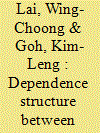

|
|
|
|
|
| Summary/Abstract |
This article investigates the linkages of the movements in Renminbi (RMB) to volatility of exchange rate returns of other currencies before and after the yuan devaluation on 11 August 2015. A comparison between the onshore Chinese yuan (CNY) and the offshore Chinese yuan (CNH) is made. Standard regression methods underestimate the tail dependence between yuan and other exchange rate volatility, as financial data are non-normally distributed, especially when extreme event occurs. We apply Gumbel copulas to capture the presence of tail dependence between RMB returns and the volatility of exchange rate returns for 13 selected currencies, and found dependencies not revealed by the standard ARCH models. The tail dependence has increased after the RMB devaluation, suggesting that RMB depreciation is associated with higher downside risks in these currencies. This is most obvious in the currencies of Asian and ASEAN-5 countries that have strong trade and financial linkages with China. The dependence structure has shifted away from the dominance of onshore CNY rates before the devaluation to the growing importance of more volatile offshore CNH rates after the devaluation. Hence, any large depreciation in CNH will lead to a higher volatility in the other exchange rate returns, and the corresponding downside currency risks are higher than those of the CNY.
|
|
|
|
|
|
|
|
|
|
|
|
|
|
|
|
| 6 |
ID:
162248


|
|
|
|
|
| Summary/Abstract |
We use the k-th-order nonparametric causality test at monthly frequency over the period of 1985:1 to 2016:06 to analyze whether geopolitical risks can predict movements in stock returns and volatility of 24 global defense firms. The nonparametric approach controls for the existing misspecification of a linear framework of causality, and hence, the mild evidence of causality obtained under the standard Granger tests cannot be relied upon. When we apply the nonparametric test, we find that there is no evidence of predictability of stock returns of these defense companies emanating from the geopolitical risk measure. However, the geopolitical risk index does predict realized volatility in 50% of the companies. Our results indicate that while global geopolitical events over a period of time is less likely to predict returns, such global risks are more inclined in affecting future risk profile of defense firms.
|
|
|
|
|
|
|
|
|
|
|
|
|
|
|
|
| 7 |
ID:
176853


|
|
|
|
|
| Summary/Abstract |
In this paper, we estimate volatility spillovers before and after the introduction of a new cable linking different electricity market zones. Using wholesale electricity prices for Sardinia and two neighbouring Italian market zones for the period 2005–2015, we focus on the effects of the SAPEI cable, fully operational since March 2011. VAR-GARCH estimates indicate that the SAPEI cable allowed for stronger volatility transmission towards Sardinia, a smaller zone and a net importer from its new neighbour, the Central Southern zone, albeit the effect was significant only off-peak. Higher conditional correlations between zonal prices are also observed after the cable was introduced. Some implications are drawn about the interaction between market size, export positions, congestion, and volatility transmission.
|
|
|
|
|
|
|
|
|
|
|
|
|
|
|
|
| 8 |
ID:
098775
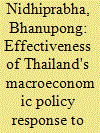

|
|
|
| 9 |
ID:
168862


|
|
|
|
|
| Summary/Abstract |
In this research, we analyzed how Turkish financial markets and foreign investors in the stock market reacted to the terror attacks in Turkey. Our analysis, which was performed using the terror index for the stock market and the foreign exchange market, revealed that returns, abnormal returns, and cumulative abnormal returns were not affected by the terror attacks; however, foreign investors in the stock market were affected. When the geographic regions of the terror attacks were analyzed, the findings showed that foreign investors were negatively affected mainly by the terror attacks that occurred in southeast Anatolia. Attack type and target type were important only for foreign investors. An evaluation of the interaction between the terror attacks and the markets with the involvement of the terrorist organizations indicated that only the foreign investors in the stock market were affected by Al-Qaeda and PKK-linked terror attacks. An evaluation of the effect of terror attacks in foreign countries on Turkish financial markets revealed no effect on the domestic stock market and foreign exchange markets. We also examined the volatility spillovers from the terror index to the stock market and found that terrorist attacks increased the volatility of the stock market.
|
|
|
|
|
|
|
|
|
|
|
|
|
|
|
|
| 10 |
ID:
092500
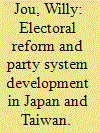

|
|
|
| 11 |
ID:
069813


|
|
|
| 12 |
ID:
163505


|
|
|
|
|
| Summary/Abstract |
The framework of “one currency, two markets” makes China’s currency market quite unique compared to its Western counterparts. In this study, we characterize the linkage between the onshore and offshore Renminbi exchange rates, and estimate the effect of the recent Renminbi market reforms against the backdrop of Renminbi internationalization. Using GARCH-type models, we find robust evidence of the volatility clustering phenomenon and the leverage effect in the pricing differential between the onshore and offshore exchange rates. We also find that the recent Renminbi currency market reforms all increase the volatility of the pricing differential between the two Renminbi markets, while these reforms are proved to either enlarge or shrink the pricing differential.
|
|
|
|
|
|
|
|
|
|
|
|
|
|
|
|
| 13 |
ID:
163569


|
|
|
|
|
| Summary/Abstract |
This paper provides estimates of quantile regression models of the relationship between Italian day-ahead electricity prices, the supply of renewables and the inception of a new cable (SAPEI, linking Sardinia with the Italian peninsula), in the 2006–2015 time window. The results confirm the merit order effects detected in the existing literature, both for photovoltaics and wind power, more strongly in market conditions characterised by moderately low price levels and with some implied increase in volatility. The new cable has apparently challenged the ability of power generating companies to extract value through price spikes, has mitigated volatility, and its effects have been complementary with those of renewables. Effects from photovoltaics are more sensitive to robustness checks. Differences across zonal markets are nonetheless detected.
|
|
|
|
|
|
|
|
|
|
|
|
|
|
|
|
| 14 |
ID:
101340
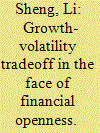

|
|
|
|
|
| Publication |
2010.
|
| Summary/Abstract |
This paper analyses optimal tradeoffs between economic growth and economic volatility given the risk of open capital markets in developing countries due to their financial vulnerability to unfettered capital flows. It is argued that free policy choices are efficiently superior to free capital mobility and that a developing country can be open to higher growth and lower volatility only if its financial system is substantially strengthened.
|
|
|
|
|
|
|
|
|
|
|
|
|
|
|
|
| 15 |
ID:
100752


|
|
|
|
|
| Publication |
2010.
|
| Summary/Abstract |
A unified index of income inequality, volatility, and mobility risk is presented, and measurements based on US and Chinese panel data calculated. China is found to have higher-income volatility than the US in recent data, so that long-run inequality is comparable in the two countries, and short-run inequality overstates long-run inequality more in China than in the US. In both countries volatility and income inequality are increasing over time.
|
|
|
|
|
|
|
|
|
|
|
|
|
|
|
|
| 16 |
ID:
112887
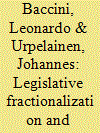

|
|
|
|
|
| Publication |
2012.
|
| Summary/Abstract |
This article shows that legislative fractionalization and leftward (but not rightward) partisan shifts increase the volatility of public R&D expenditures in new energy technologies. We develop a highly accurate estimator for public energy R&D expenditures, and examine deviations from the estimated values using data for member states of the International Energy Agency, 1981-2007. Given that unpredictable fluctuation in public spending on new energy technology reduces the positive effect of such spending on innovation, our empirical analyses imply that countries with fractionalized legislatures can improve the performance of their energy technology programs by enacting institutional mechanisms that reduce the volatility of public spending. Similarly, the results indicate that left-wing and right-wing governments can improve the performance of public technology programs through agreements that distribute gains in such a fashion that partisan shifts do not cause spending cuts. Contravening the conventional wisdom, we also find that public energy R&D is unusually stable in the United States.
|
|
|
|
|
|
|
|
|
|
|
|
|
|
|
|
| 17 |
ID:
173196
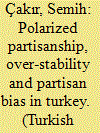

|
|
|
|
|
| Summary/Abstract |
A vast literature demonstrates that partisanship has a stabilizing impact on politics, as it limits electoral volatility. Recent studies have also shown that polarization increases partisanship, thus contributing to electoral stability. Focusing on Turkey, an unconsolidated and highly polarized democracy, this study investigates the role of partisanship in a comparative context by means of data from the Comparative Study of Electoral Systems project. I find that Turkey (among more than 40 countries) is a very high-partisanship country, where partisanship greatly shapes the evaluations of short-term determinants of vote and the vote itself. This research also shows that partisanship in Turkey is associated with very low electoral volatility and defection rates. Moreover, the degree of identification also plays a significant role in its impact on volatility and defection. These findings from the Turkish case offer insights and stimulate a new normative debate on the role of partisanship in unconsolidated democracies.
|
|
|
|
|
|
|
|
|
|
|
|
|
|
|
|
| 18 |
ID:
152765


|
|
|
|
|
| Summary/Abstract |
Since the pioneering studies of Mandelbrot, a great deal of interest has arisen for the parameters of fractal finance theory. With this in mind, the present study attempts to examine the risk composition of S&P 500 index industries through panel data analysis. In the modelling of industries’ stock return risk, we use internal and external variables which are related to the companies’ financial ratios and stock market movements. In the first section (sigma-risk) of the study, we model the stock return risk through standard deviation, while in the second section (alpha-risk), the alpha parameter of stable distributions has been used for the same purpose. Panel data analysis results demonstrate that in the sigma-risk model for the healthcare industry, there is a significant internal variable (roa) that negatively affects the industry risk. However, for the alpha-risk model, some significant variables are obtained for the service industry. Another important finding is the changing level of market risk under the two models. While in the sigma-risk model, the magnitude of the market (external) risk variable is high, under the alpha-risk model, we have seen that market risk is relatively low despite the fact that it still has the highest effect on industry risk.
|
|
|
|
|
|
|
|
|
|
|
|
|
|
|
|
| 19 |
ID:
097199


|
|
|
|
|
| Publication |
2010.
|
| Summary/Abstract |
This paper examines the impacts of world, country, and sector-specific variables on the stock return volatility of twenty-seven US sectors in the short- and long-run, accounting for the asymmetric shocks based on GARCH models. In the standard GARCH model the two world variables, oil and Morgan Stanley Capital Index (MSCI), have differing impacts on the US equity sector returns' volatility, with oil price dampening it while MSCI heightening it for most sectors. This result underlines the need for hedging more against world capital market risk relative to oil risk which is probably hedged by many sectors. The world and country factors' impacts are not as pervasive across the board, compared with the sector-specific impacts of the P/B ratio and trading volume which affect almost all sectors. Increases in the P/B ratio would reduce the aggregate volatility, while increases in the trading volume would heighten it for all sectors. Asymmetry of factor impacts on volatility is also found for most sectors. Most of the GARCH factor results are confirmed in the CGARCH model with the exception of the impact of interest rate on the short-lived transitory volatility. Finally, interesting econometric results on the inclusion or exclusion of trading volumes are discussed.
|
|
|
|
|
|
|
|
|
|
|
|
|
|
|
|
| 20 |
ID:
160414
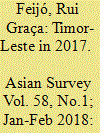

|
|
|
|
|
| Summary/Abstract |
The year 2017 dawned in Timor-Leste with positive promises. Diplomatic efforts to secure a new maritime boundary and improve access to natural resources ended in a favorable deal. Elections let people have a voice on disputes of the previous year. But the returns took many by surprise, and instability returned to the arena.
|
|
|
|
|
|
|
|
|
|
|
|
|
|
|
|
|
|
|
|
|